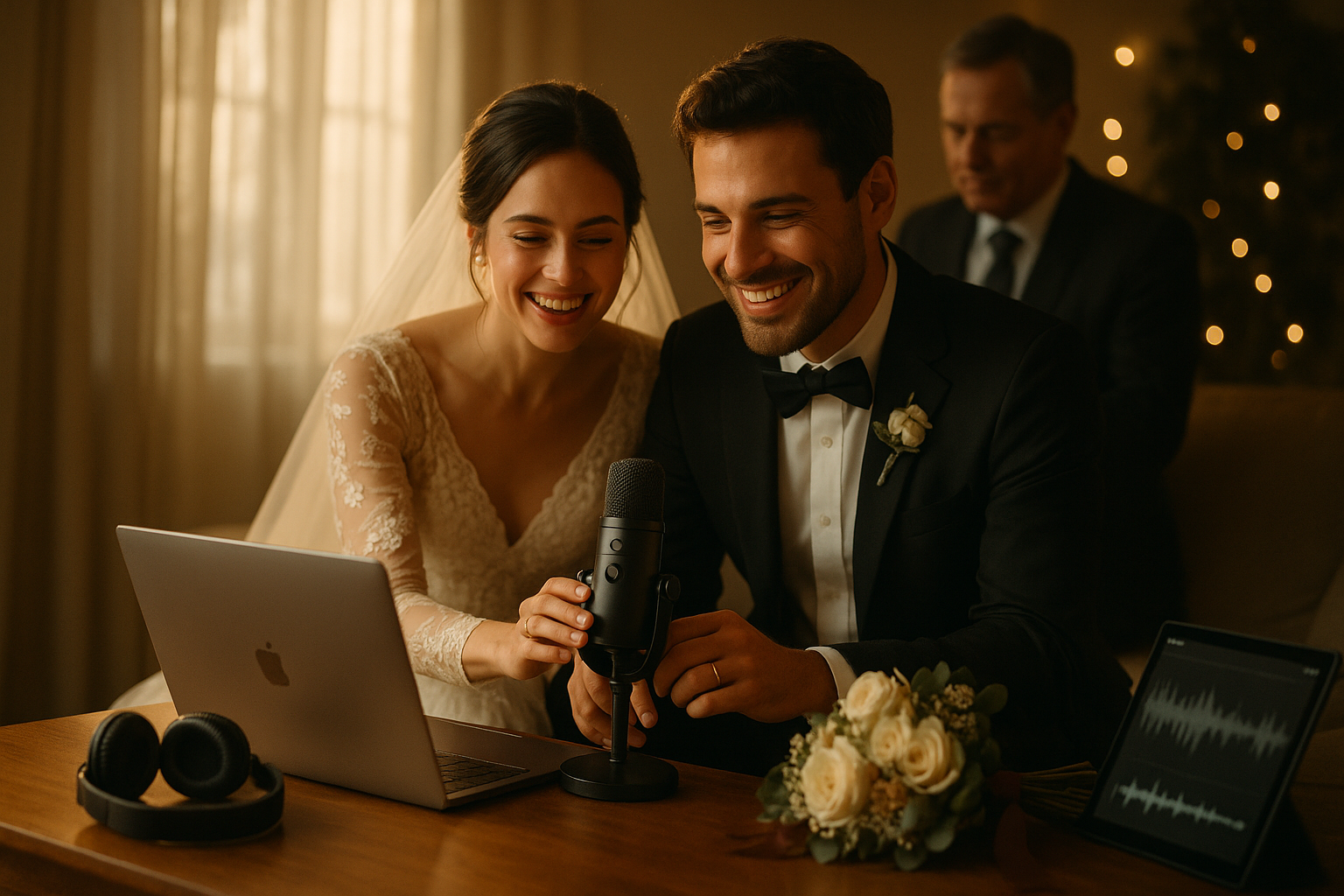Planning a virtual wedding? Congratulations! As you embark on this exciting journey, ensuring clear and high-quality audio is crucial for a memorable online ceremony. Let’s dive into some essential tips to help you achieve the best sound experience for your special day.
Choose the Right Microphone for Your Virtual Wedding
Investing in a quality microphone can make a significant difference. While built-in microphones on laptops or phones might suffice, external microphones, such as USB condenser mics or lapel mics, offer superior sound quality. Position the microphone 6-12 inches from your mouth to capture clear audio without distortion. Noise-canceling headphones can also help reduce feedback, making communication smoother for you and your attendees. Learn more about setting up reliable equipment for virtual events.
Test Your Audio Equipment Before the Ceremony
Conducting a test run is essential to identify and resolve any potential issues. This practice ensures that your audio equipment functions correctly and helps you familiarize yourself with the setup. As highlighted by Easy Weddings, testing allows you to iron out kinks and see what is or isn’t possible. Read more about streaming your virtual wedding without a hitch.
Optimize Your Internet Connection for Uninterrupted Audio
A stable internet connection is vital for seamless audio transmission. Whenever possible, use a wired Ethernet connection instead of Wi-Fi to minimize interference and signal drops. Ensure your internet speed meets the requirements for high-quality streaming to prevent audio lag or dropouts. Discover more about ensuring reliable internet for virtual events.
Minimize Background Noise During Your Virtual Ceremony
Choose a quiet location for your ceremony to reduce background noise. Inform household members about the event to avoid interruptions. Using directional microphones can help isolate your voice and minimize ambient sounds. Explore tips for better audio capture at weddings.
Position Your Microphone Strategically
Proper microphone placement is key to capturing clear and balanced audio. For instance, lapel microphones should be positioned about 10 cm from the face to avoid picking up other sounds from around you. Learn more about optimizing your PA and sound quality.
Have a Backup Audio Plan in Place
Technical glitches can occur, so it’s wise to have a backup audio source. Recording a backup audio track using a separate device, such as a digital audio recorder, ensures you have a secondary source if issues arise with the primary recording. Read more about recording backup audio.
Communicate with Participants About Audio Expectations
Inform your officiant, speakers, and participants about the audio setup and provide guidelines on microphone usage. This ensures everyone is prepared and helps maintain consistent audio quality throughout the ceremony. Discover more about communicating with the wedding party.
Consider the Acoustics of Your Chosen Venue
Different venues have varying acoustic properties. Understanding these can help you plan your audio capture strategy. For example, outdoor venues often have minimal natural reverb but can be subject to wind and other environmental noises. Use wind protection for your microphones and position them to capture sound from the subjects, not the surroundings. Learn more about considering venue acoustics.
Plan for Post-Production Audio Enhancements
Even with the best audio capture techniques, some issues might need to be addressed in post-production. Ensure you have the tools and expertise to clean up audio, reduce noise, and balance levels to create a polished final product. If audio post-production isn’t your strength, consider outsourcing it to a dedicated post-production studio that specializes in sound design for wedding films. Explore more about planning for post-production.
Engage a Virtual Emcee to Manage Audio Flow
Having a virtual emcee or host can help manage the audio flow during your ceremony. This person can guide the event, introduce speakers, and ensure smooth transitions, enhancing the overall experience for your virtual guests. Read more about having a virtual emcee.
Provide Clear Instructions to Virtual Guests
Ensure your virtual guests are informed about the platform being used and provide them with clear instructions on how to join and participate. This preparation helps minimize technical issues and ensures everyone can hear and engage with the ceremony. Discover more about Zoom wedding ceremony tips.
FAQs
What type of microphone is best for a virtual wedding?
External microphones, such as USB condenser mics or lapel mics, offer superior sound quality compared to built-in microphones. Position the microphone 6-12 inches from your mouth to capture clear audio without distortion. Learn more about setting up reliable equipment for virtual events.
How can I test my audio setup before the virtual wedding?
Conduct a test run with all equipment in the chosen location to identify and resolve any potential issues. This practice ensures that your audio equipment functions correctly and helps you familiarize yourself with the setup. Read more about streaming your virtual wedding without a hitch.
Why is a wired internet connection recommended for virtual weddings?
A wired Ethernet connection provides a more stable and reliable signal compared to Wi-Fi, minimizing interference and signal drops during your virtual ceremony. Discover more about ensuring reliable internet for virtual events.
How can I minimize background noise during my virtual ceremony?
Choose a quiet location, inform household members about the event to avoid interruptions, and use directional microphones to isolate your voice and minimize ambient sounds. Explore tips for better audio capture at weddings.
What should I do if technical issues arise during the ceremony?
Having a backup audio source, such as a digital audio recorder, ensures you have a secondary source if issues arise with the primary recording. Additionally, having a virtual emcee can help manage the event and address any technical issues promptly. Read more about having a virtual emcee.
By following these tips, you can ensure that your virtual wedding ceremony is heard loud and clear by all your guests, creating a memorable and seamless experience. If you have any questions or need further assistance, feel free to contact us at Virtual Same Day Marriage. We’re here to help make your special day perfect!




